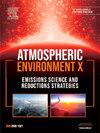Quantification of natural gas and other hydrocarbons from production sites in northern West Virginia using tracer flux ratio methodology.
IF 3.8
Q2 ENVIRONMENTAL SCIENCES
引用次数: 0
Abstract
Tracer flux ratio (TFR) methodology performed downwind of 15 active oil and natural gas production sites in Ohio County, West Virginia sought to quantify air pollutant emissions over two weeks in April 2018. In coordination with a production company, sites were randomly selected depending on wind forecasts and nearby road access. Methane (CH4), ethane (C2H6), and tracer gas compounds (acetylene and nitrous oxide) were measured via tunable infrared direct absorption spectroscopy. Ion signals attributed to benzene (C6H6) and other volatile gases (e.g., C7 - C9 aromatics) were measured via proton-transfer reaction time-of-flight mass spectrometry. Short-term whole facility emission rates for 12 sites are reported. Results from TFR were systematically higher than the sum of concurrent on-site full flow sampler measurements, though not all sources were assessed on-site in most cases. In downwind plumes, the mode of the C2H6:CH4 molar ratio distribution for all sites was 0.2, which agreed with spot sample analysis from the site operator. Distribution of C6H6:CH4 ratios was skew but values between 1 and 5 pptv ppbv-1 were common. Additionally, the aromatic profile has been attributed to condensate storage tank emissions. Average ratios of C7 - C9 to C6H6 were similar to other literature values reported for natural gas wells.使用示踪通量比方法对西弗吉尼亚州北部生产地点的天然气和其他碳氢化合物进行量化。
追踪通量比(TFR)方法在西弗吉尼亚州俄亥俄县的15个活跃石油和天然气生产基地的下风处进行,旨在量化2018年4月两周内的空气污染物排放量。在与一家生产公司的协调下,根据风力预报和附近的道路通道随机选择了现场。甲烷(CH4)、乙烷(C2H6)和示踪气体化合物(乙炔和一氧化二氮)通过可调谐红外直接吸收光谱进行测量。通过质子转移反应飞行时间质谱法测量苯(C6H6)和其他挥发性气体(如C7-C9芳烃)的离子信号。报告了12个地点的短期整体设施排放率。TFR的结果系统地高于同时进行的现场全流采样器测量的总和,尽管在大多数情况下并不是所有来源都进行了现场评估。在顺风羽流中,所有站点的C2H6:CH4摩尔比分布模式为0.2,这与站点操作员的现场样本分析一致。C6H6:CH4比率的分布是偏斜的,但在1和5pptv ppbv-1之间的值是常见的。此外,芳烃分布已归因于冷凝液储罐的排放。C7-C9与C6H6的平均比值与其他文献报道的天然气井值相似。
本文章由计算机程序翻译,如有差异,请以英文原文为准。
求助全文
约1分钟内获得全文
求助全文
来源期刊

Atmospheric Environment: X
Environmental Science-Environmental Science (all)
CiteScore
8.00
自引率
0.00%
发文量
47
审稿时长
12 weeks
 求助内容:
求助内容: 应助结果提醒方式:
应助结果提醒方式:


